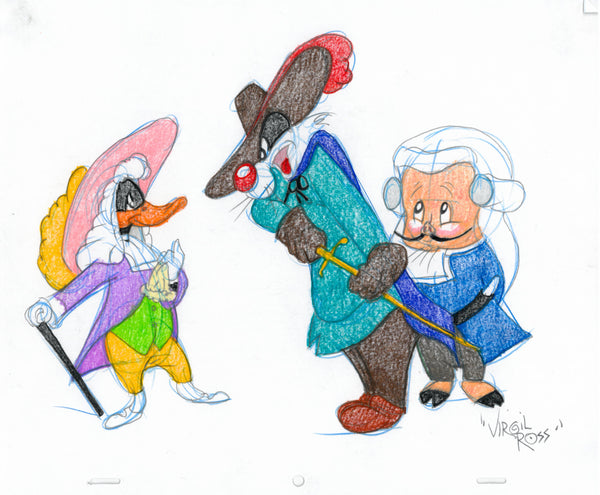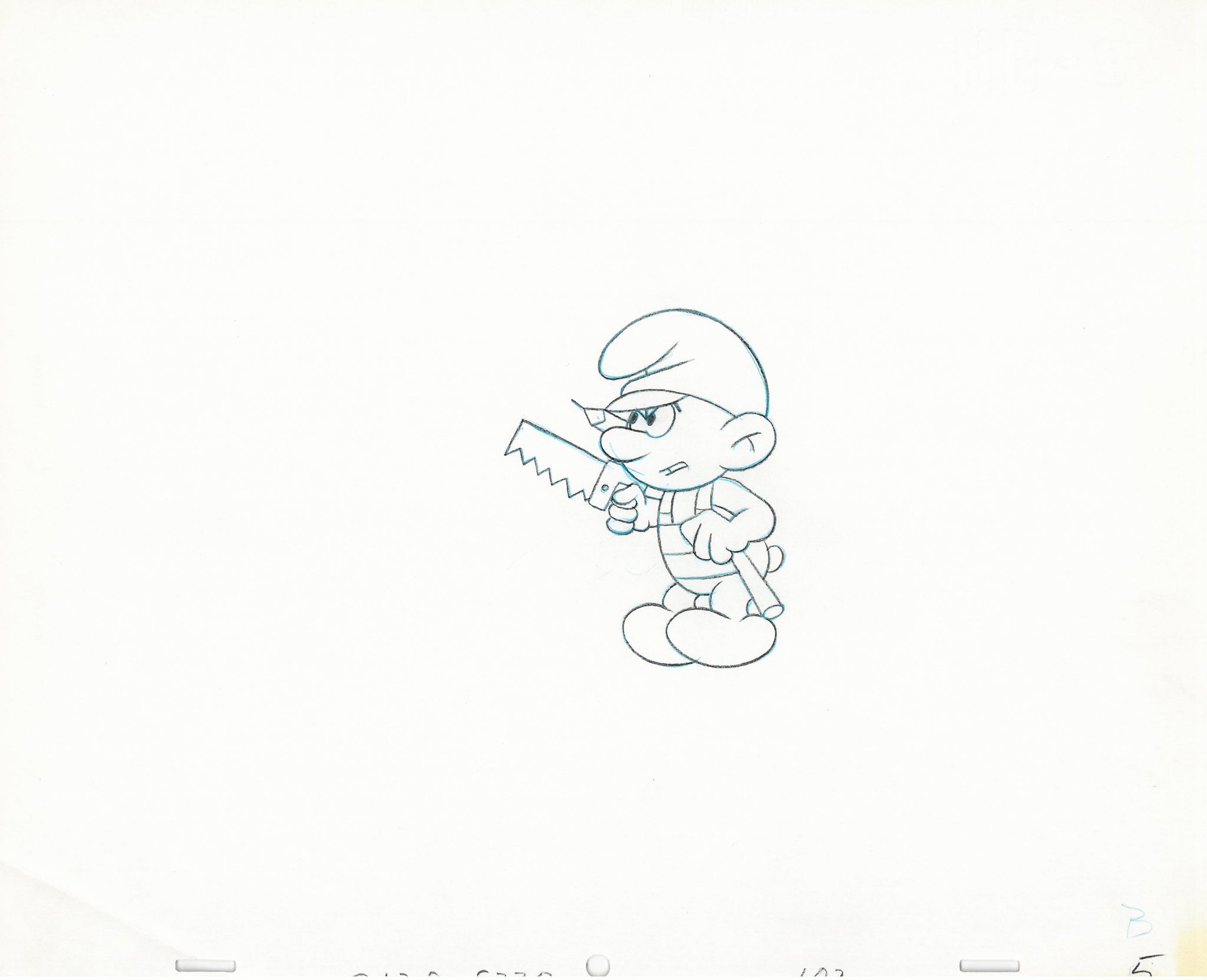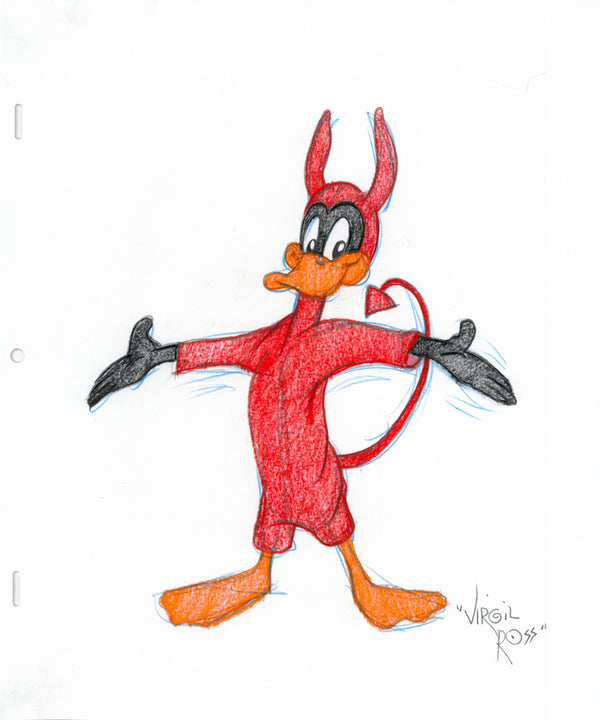USE SHOP PAY FOR 4 EQUAL NO INTEREST PAYMENTS
+GLOSSARY
View the full glossary here for a better understanding of the art.
1980's Smurfs Original Cel Production Drawing Hanna-Barbera
$55.00
- 1980’s Smurfs
- From an unknown production
- Hand-drawn Pencil Drawing on Animation Paper
- One-of-a-Kind Animation Production Layout Drawing
- Drawing Size: 12 Field (10.5" x 12")
- Unmatted, Unframed
The Smurfs is a Belgian comic franchise centered on a fictional colony of small, blue, human-like creatures who live in muhsroom shaped houses in the forest. The Smurfs was first created and introduced as a series of comic characters by the Belgian Comics artist Peyo (the pen name of Pierre Culliford) in 1958, wherein they were known as Les Schtroumpfs. There are more than 100 Smurf characters, and their names are based on adjectives that emphasise their characteristics, such as "Jokey Smurf", who likes to play practical jokes on his fellow smurfs. "Smurfette" was the first female Smurf to be introduced in the series. The Smurfs wear Phygirian caps, which came to represent freedom during the modern era.
The word “smurf” is the original Dutch translation of the French "schtroumpf", which, according to Peyo, is a word he invented during a meal with fellow cartoonist André Franquin when he could not remember the word salt.
The Smurfs franchise began as a comic and expanded into advertising, films, TV series, ica capades, video games, theme parks, and dolls.
The period from 1966 to 1990 was considered the "Golden Age of Saturday Morning Cartoon" where all television networks — by all, we mean three: NBC, ABC and CBS — made conscious decisions devoting their weekend blocks to showing animated programs targeted for children during the mornings. Though as time went on, live-action kids' shows as well as other family-friendly media began taking over the airwaves, meaning ratings started to go down and the future of established Saturday morning cartoons became uncertain. Eventually, animated studios and network programmers fell into a pattern of reusing popular formulas, some taking characters from their most popular shows and pairing them together in order to make them "perform" or "compete" much like how their live-action counterparts in Sitcoms and Soap Operas did on Prime Time shows.
In 1979, television executive and producer Fred Silverman turned President and CEO of NBC brought his daughter a plush Smurf doll from a local toy shop during a network trip to Aspen, Colorado. Upon his return, Silverman contacted cofounder Joseph Barbera of Hanna-Barbera Productions, charging him on acquiring the rights to the Smurfs, guaranteeing the studio an on-air commitment if they could make an animated cartoon series around the Belgian comics. Doing as he was told, Barbera began a two-year trip to the television screen, veering the Smurfs far from Pierre "Peyo" Culliford's 1958 creation before coming back to a familiar form.
Even though the contract Peyo had with NBC, S.E.P.P. (La Société d'Edition, de Presse et de Publicité) and Hanna-Barbera Productions gave him the power to veto any changes made to his creation, Hanna-Barbera had to make changes to the comics before making them into episodes. They included changing 'The Black Smurfs' from "Les Schtroumpfs noirs" to purple as well as changing the 'Swoofs', which are basically the Smurfs in disguise to green from the reddish orange skin tone from "Le Cosmoschtroumpf" ("The Astrosmurf"). Hanna-Barbera also changed Brainy from being whacked on the head with a blunt object as punishment in the printed stories to being physically thrown out of the Smurf Village in the cartoon, which was later carried into the 2011 movie, in fear of young viewers hitting those they despise on the head.
The Smurfs animated series finally debuted on Saturday morning of September 12, 1981, capturing forty two percent of the audience, thus making it the most highly rated children's program in more than eight years, not to mention the highest rated program on NBC in roughly two decades. Smurfs even outperformed a number of successful prime time shows in terms of viewing percentages. In terms of voices, Don Messick, Frank Welker, June Foray, Paul Winchell, Michael Bell, Alan Young, Hamilton Camp, and Charlie Adler, among others provided their vocal talents to the show.
While many of Peyo's original Smurfs comics such as "L'Apprenti Schtroumpf" ("The Smurf Apprentice"), "Les Schtroumpfs et le Cracoucass" ("The Smurfs and the Howlibird") and "Le Schtroumpfissme" ("King Smurf") were adapted for the first season, Hanna-Barbera reached a point where new characters need to be introduced as well as creating original stories for the series. Johan and Pirlouit, called Peewit in English, made their television debut in the second season, becoming recurring characters as well as Bigmouth, who only made one appearance in the comics. Gargamel, Azrael, Princess Savina, the King, Dame Barbra and Homnibus made their animated appearances from the comics as well. Other allies of the Smurfs created specifically for the animated series include Prince-turned-King Gerard, the Pussywillow Pixies, Gourdy, Marina, Selwyn and Tallulah just to name a few. Besides additional allies, supplementary antagonists such as Chlorhydris, Gargamel's godfather Lord Balthazar as well as Scruple, Gargamel's apprentice starting from around season six appeared as adversaries to the Smurfs.
Despite the Smurfs being cancelled by NBC, which was getting rid of its animated Saturday morning lineup to allow for more news programming, Hanna-Barbera would animate the characters one last time in a drug abuse prevention special with other popular Saturday morning showsnote called Cartoon All-Stars to the Rescue. A handful of Smurfs, along with Papa, Hefty and Brainy, with a quick cameo from Harmony in the comic book lying on the floor, appeared in a limited amount of appearance under the orders of Smurfs' creator Pierre "Peyo" Culliford.
SHIPPING: We strive to ship within 1 day of cleared payment. We treat every item we sell with the extra care it deserves. Cels, drawings and sculptures are packed so that they will stay safe during every step of the shipping process. Due to the packing materials we use our shipping prices may seem higher than other sellers who might put a cel into a tube or thin envelope. We are not making a profit on shipping. Only the cost we pay is passed along to you. Please let us know if you need to receive your purchase by a particular date. Email with any questions or concerns.
INTERNATIONAL BUYERS TAKE NOTE: Import duties, taxes and charges are not included in the item price or shipping charges. These charges are the buyer's responsibility. Please check with your country's customs office to determine what these additional costs will be prior to bidding/buying. These charges are normally collected by the delivering freight (shipping) company or when you pick the item up; do not confuse them for additional shipping charges. We do not mark merchandise values below value or mark items as "gifts" - US and International government regulations prohibit such behavior. All Customs Forms will reflect the ACTUAL price that the bidder paid for the merchandise. [For example, I will not claim on the customs form that the bidder paid $10.00, if the bidder actually paid $30.00] Please do not ask us to do so.
Note: All items are shipped FOB. This means that the sellers (The Cricket Gallery’s) liability for the item ends upon our delivery of the package to the shipping agent. It is the Buyers responsibility to insure the package against loss, damages or other unforeseen circumstances. Should the Buyer want The Cricket Gallery, to provide insurance we will do so at the Buyer’s request in writing and upon the payment of an additional charge for such insurance. Buyers outside the USA are likewise responsible for insurance as well as all taxes, tariffs, customers and other charges imposed for international shipments.
Collections: Active, ALL OTHER STUDIOS, DRAWINGS, Hanna-Barbera, Other Studios, vintage
Type: Unknown Type
Related Items
Signed Warner Brothers Original 1990's Color Drawing Virgil Piano Bugs Bunny
$425.00
An original drawing, in colored pencil, of Bugs Bunny at the Piano signed by legendary Warner. Bros and Hanna Barbera. animator, VIRGIL ROSS. This drawing is...
View full product details
Signed Warner Brothers Original 1990's Color Drawing Virgil Daffy Duck, Sylvester, Porky Pig
$425.00
An original drawing, in colored pencil, of Daffy Duck, Sylvester, and Porky Pig signed by legendary Warner. Bros and Hanna Barbera. animator, VIRGIL ROSS. This drawing...
View full product detailsSigned Warner Brothers Original 1990's Color Drawing Virgil Devil Daffy Duck
$425.00
An original drawing, in colored pencil, of Daffy Duck as a Devil signed by legendary Warner. Bros and Hanna Barbera. animator, VIRGIL ROSS. This drawing is...
View full product details





